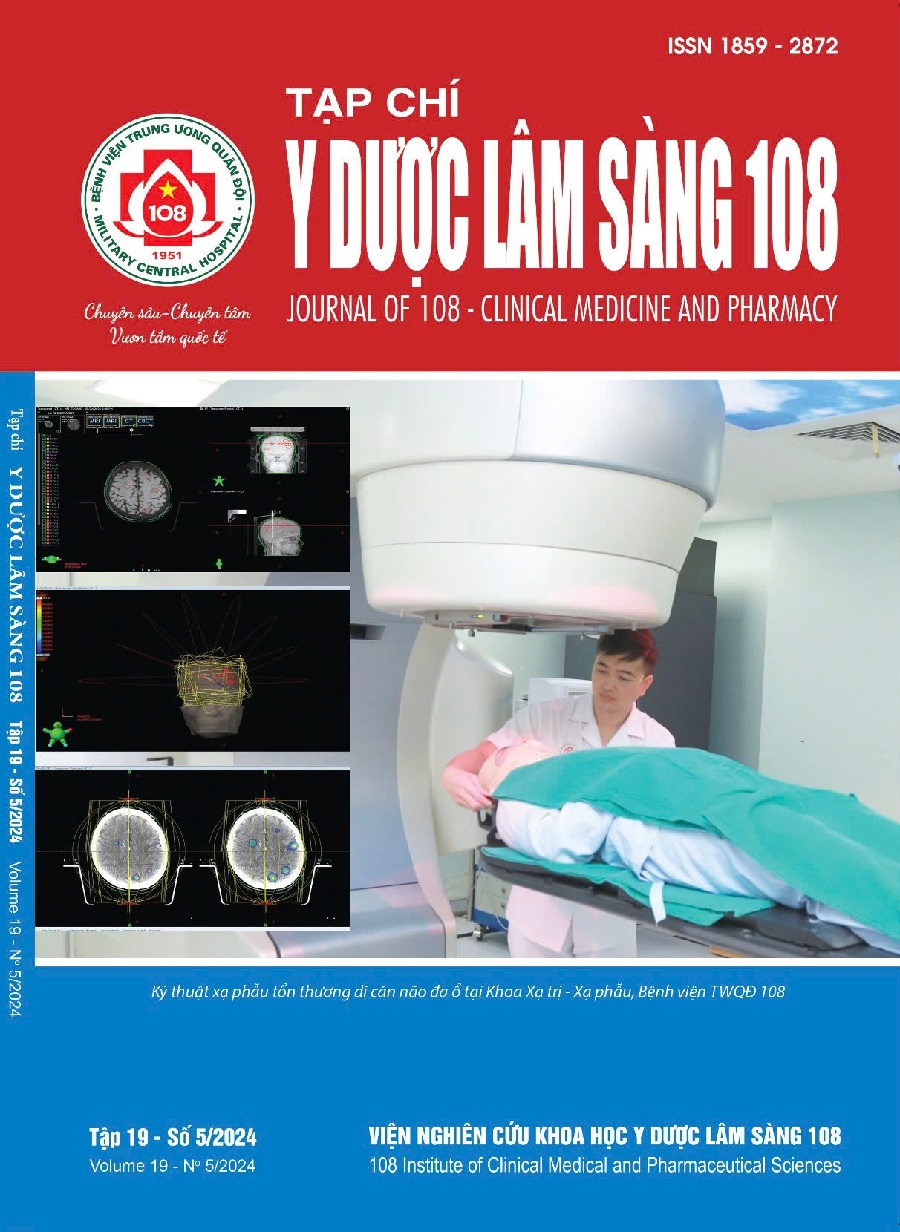Thay đổi CRP và procalcitonin trong đợt cấp bệnh phổi tắc nghẽn mạn tính có viêm phổi
Main Article Content
Keywords
Tóm tắt
Mục tiêu: Đánh giá thay đổi nồng độ C-reactive protein (CRP) và procalcitonin (PCT) huyết thanh trong đợt cấp BPTNMT có viêm phổi. Đối tượng và phương pháp: Nghiên cứu mô tả, cắt ngang trên 138 bệnh nhân (BN) chẩn đoán xác định đợt cấp BPTNMT trong đó có 92 BN đợt cấp có viêm phổi (nhóm bệnh) và 46 BN đợt cấp không có viêm phổi (nhóm chứng). Kết quả: Ở nhóm bệnh nhân BPTNMT đợt cấp có viêm phổi, trung vị nồng độ CRP (51,85 (15,53-136,65) mg/l), PCT (0,23 (0,10-0,69)ng/ml) cao hơn có ý nghĩa so với nhóm không có viêm phổi (7,60 (2,95-27,78) và 0,09 (0,05-0,22)). Tăng CRP ≥ 5mg/l và PCT ≥ 0,25ng/mL chưa thể định hướng khả năng cấy đờm dương tính với vi khuẩn. CRP có giá trị định hướng trong chẩn đoán viêm phổi ở BN đợt cấp BPTNMT với diện tích dưới đường cong ROC là 0,78 (95% KTC: 0,70-0,85), chỉ số Youden là 0,4348, ở điểm cắt CRP 40,8mg/l có độ nhạy 56% và độ đặc hiệu 87%. Kết luận: Nồng độ trung bình CRP và PCT huyết thanh ở nhóm BN đợt cấp BPTNMT có viêm phổi tăng cao hơn rõ rệt so với nhóm không viêm phổi. CRP là dấu ấn sinh học có giá trị định hướng trong chẩn đoán viêm phổi ở bệnh nhân đợt cấp BPTNMT.
Article Details
Các tài liệu tham khảo
2. Sogaard M, Madsen M, Lokke A et al (2016), Incidence and outcomes of patients hospitalized with COPD exacerbation with and without pneumonia. Int J Chron Obstruct Pulmon Dis 11: 455-465.
3. Simon L, Gauvin F, Amre DK et al (2004) Serum procalcitonin and C-reactive protein levels as markers of bacterial infection: A systematic review and meta-analysis. Clin Infect Dis 39(2): 206-217.
4. Agusti AG, Celli BR, Chen R et al (2019) Global strategy for the diagnosis, management, and prevention of COPD. Global Initiative For Chronic Obtructive Lung Disease: 23-39.
5. CDC/NHSN (2014) Surveillance Definitions for Specific Types of Infections. 30-36.
6. Pepys MB, Hirschfield GM (2003) C-reactive protein: a critical update. J Clin Invest 111(12): 1805-1812.
7. Ergan B, Sahin AA, Topeli A (2016) Serum procalcitonin as a biomarker for the prediction of bacterial exacerbation and mortality in severe COPD exacerbations requiring mechanical ventilation. Respiration 91(4): 316-324.
8. Phạm Tử Dương (2005) Xét nghiệm tế bào máu. Xét nghiệm sử dụng trong lâm sàng, Nhà xuất bản Y học, tr. 112-162.
9. Masaru S, Hironi M, Yoichi M et al (2014) Clinical features and determinants of COPD exacerbation in the Hokkaido COPD cohort study. European Respiratory Journal 43: 1289-1297.
10. Shaun H, Sheahan D, Colin H (2014) Little agreement in GOLD category using CAT and mMRC in 450 primary care COPD patients in New Zealand. Primary Care Respiratory Medicine 24(2014).
11. Perera WR, Hurst JR, Wilkinson TMA et al (2007) Inflammatory changes, recovery and recurrence at COPD exacerbation. Eur Respir J 29: 527–534.
12. Bircan A, Gokirmak M, Kilic O et al (2008) C-reactive protein levels in patients with chronic obstructive pulmonary disease: Role of infection. Med Princ Pract 17(3): 202-208.
13. Finney LJ, Vijay P, Samuel T et al (2019) Validity of the diagnosis of pneumonia in hospitalised patients with COPD. ERJ Open Research 5.
14. Mohamed KH, Abderabo MM, Ramadan ES et al (2012) Procalcitonin as a diagnostic marker in acute exacerbation of COPD. Egypt J Chest Dis Tuberc 61: 301-305.
15. Roche N, Kouassi B, Rabbat A et al (2007) Yield of sputum microbiological examination in patients hospitalized for exacerbations of chronic obstructive pulmonary disease with purulent sputum. Respiration 74(1): 19-25.
16. Sin DD, Man SF (2003) Why are patients with chronic obstructive pulmonary disease at increased risk of cardiovascular diseases? The potential role of systemic inflammation in chronic obstructive pulmonary disease. Circulation 107(11): 1514-1519, http://www.ncbi.nlm.nih.gov/pubmed/12654609.
17. Gan WQ, Man SFP, Senthilselvan A et al (2004) Association between chronic obstructive pulmonary disease and systemic inflammation: A systematic review and a meta-analysis. Thorax 59(7): 574-580.
18. Falsey AR, Becker KL, Swinburne AJ et al (2012) Utility of serum procalcitonin values in patients with acute exacerbations of chronic obstructive pulmonary disease: a cautionary note. International Journal of Chronic Obstructive Pulmonary Disease 7: 127-135.
19. Lacoma A, Prat C, Andreo F et al (2011) Value of procalcitonin, C-reactive protein, and neopterin in exacerbations of chronic obstructive pulmonary disease. International Journal of Chronic Obstructive Pulmonary Disease 6: 157-169.
20. Chang CH, Tsao KC, Hu HC et al (2015) Procalcitonin and C-reactive protein cannot differentiate bacterial or viral infection in COPD exacerbation requiring emergency department visits. International Journal of Chronic Obstructive Pulmonary Disease 10: 767-774.
21. Đặng Quỳnh Giao Vũ, Lê Thượng Vũ (2018) Đặc điểm lâm sàng và kết cục của viêm phổi ở bệnh nhân bệnh phổi tắc nghẽn mạn tính. Tạp chí Hội hô hấp tp.Hồ Chí Minh, 56, tr. 12-24.
22. Huerta A, Crisafulli E, Menéndez R et al (2013) Pneumonic and nonpneumonic exacerbations of COPD: inflammatory response and clinical characteristics. Chest 144(4): 1134-1142.
 ISSN: 1859 - 2872
ISSN: 1859 - 2872
